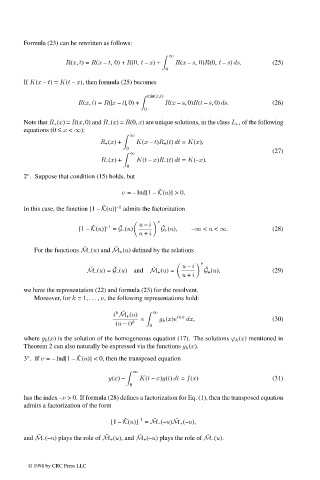Page 590 - Handbook Of Integral Equations
P. 590
Formula (23) can be rewritten as follows:
∞
R(x, t)= R(x – t,0) + R(0, t – x)+ R(x – s,0)R(0, t – s) ds. (25)
0
If K(x – t)= K(t – x), then formula (25) becomes
min(x,t)
R(x, t)= R(|x – t|,0) + R(x – s,0)R(t – s,0) ds. (26)
0
Note that R + (x)= R(x, 0) and R – (x)= R(0, x) are unique solutions, in the class L + , of the following
equations (0 ≤ x < ∞):
∞
R + (x)+ K(x – t)R + (t) dt = K(x),
0
(27)
∞
R – (x)+ K(t – x)R – (t) dt = K(–x).
0
2 . Suppose that condition (15) holds, but
◦
ˇ
ν = – Ind[1 – K(u)] > 0.
ˇ
In this case, the function [1 – K(u)] –1 admits the factorization
ν
u – i
–1
ˇ
ˇ
ˇ
[1 – K(u)] = G – (u) G + (u), –∞ < u < ∞. (28)
u + i
ˇ
ˇ
For the functions M – (u) and M + (u)defined by the relations
u – i ν
ˇ
ˇ
ˇ
ˇ
M – (u)= G – (u) and M + (u)= G + (u), (29)
u + i
we have the representation (22) and formula (23) for the resolvent.
Moreover, for k =1, ... , ν, the following representations hold:
k ˇ
i M + (u) ∞ iux
= g k (x)e dx, (30)
(u – i) k 0
where g k (x) is the solution of the homogeneous equation (17). The solutions ϕ k (x) mentioned in
Theorem 2 can also naturally be expressed via the functions g k (x).
ˇ
3 .If ν = – Ind[1 – K(u)] < 0, then the transposed equation
◦
∞
y(x) – K(t – x)y(t) dt = f(x) (31)
0
has the index –ν > 0. If formula (28) defines a factorization for Eq. (1), then the transposed equation
admits a factorization of the form
ˇ
ˇ
ˇ
[1 – K(u)] –1 = M – (–u)M + (–u),
ˇ
ˇ
ˇ
ˇ
and M – (–u) plays the role of M + (u), and M + (–u) plays the role of M – (u).
© 1998 by CRC Press LLC
© 1998 by CRC Press LLC
Page 573

